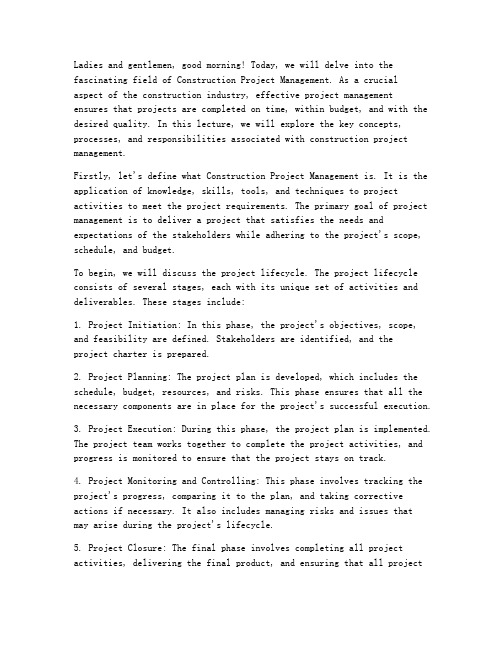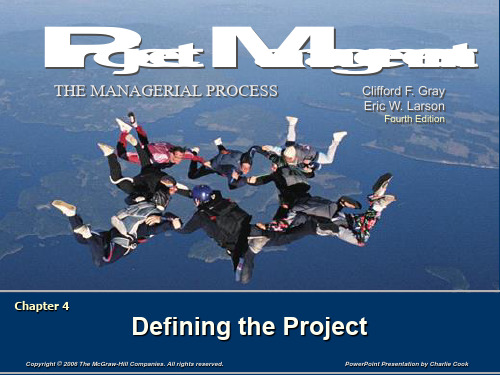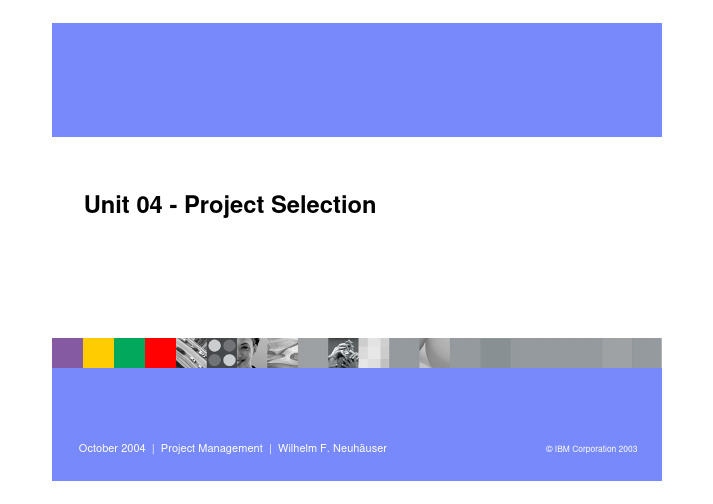项目管理Lecture4
工程项目管理英文讲课稿

Ladies and gentlemen, good morning! Today, we will delve into the fascinating field of Construction Project Management. As a crucialaspect of the construction industry, effective project management ensures that projects are completed on time, within budget, and with the desired quality. In this lecture, we will explore the key concepts, processes, and responsibilities associated with construction project management.Firstly, let's define what Construction Project Management is. It is the application of knowledge, skills, tools, and techniques to project activities to meet the project requirements. The primary goal of project management is to deliver a project that satisfies the needs and expectations of the stakeholders while adhering to the project's scope, schedule, and budget.To begin, we will discuss the project lifecycle. The project lifecycle consists of several stages, each with its unique set of activities and deliverables. These stages include:1. Project Initiation: In this phase, the project's objectives, scope, and feasibility are defined. Stakeholders are identified, and theproject charter is prepared.2. Project Planning: The project plan is developed, which includes the schedule, budget, resources, and risks. This phase ensures that all the necessary components are in place for the project's successful execution.3. Project Execution: During this phase, the project plan is implemented. The project team works together to complete the project activities, and progress is monitored to ensure that the project stays on track.4. Project Monitoring and Controlling: This phase involves tracking the project's progress, comparing it to the plan, and taking corrective actions if necessary. It also includes managing risks and issues that may arise during the project's lifecycle.5. Project Closure: The final phase involves completing all project activities, delivering the final product, and ensuring that all projectobjectives have been met. This phase also includes documenting lessons learned and conducting a project review.Now, let's discuss the key processes involved in construction project management. These processes are:1. Project Integration Management: This process ensures that all the project components work together effectively. It involves coordinating and integrating all the project activities, ensuring that they alignwith the project objectives.2. Project Scope Management: This process involves defining, verifying, and controlling the project scope. It ensures that the project deliverables meet the stakeholders' needs and expectations.3. Project Schedule Management: This process involves developing and managing the project schedule. It ensures that the project is completed on time by planning, scheduling, and controlling the project activities.4. Project Cost Management: This process involves estimating, budgeting, and controlling the project costs. It ensures that the project is completed within the approved budget.5. Project Quality Management: This process involves planning, implementing, and controlling quality activities to meet the project requirements. It ensures that the project deliverables meet the desired quality standards.6. Project Resource Management: This process involves acquiring, developing, and managing the project resources. It ensures that the project has the necessary resources to complete the project activities.7. Project Communication Management: This process involves planning, implementing, and controlling the project communication activities. It ensures that the project information is effectively communicated to the stakeholders.8. Project Risk Management: This process involves identifying, analyzing, and responding to project risks. It ensures that potential risks are minimized and managed effectively.9. Project Procurement Management: This process involves acquiring goods and services from external sources. It ensures that the project requirements are met through effective procurement activities.In conclusion, Construction Project Management is a complex and dynamic field that requires a comprehensive understanding of various processes, skills, and tools. As a project manager, it is essential to have a solid grasp of these concepts to ensure the successful delivery of construction projects. Thank you for your attention, and I hope you find this lecture informative and beneficial.。
项目管理第四章讲义

第四章项目进度管理学习目标了解项目进度管理包括的工作过程;了解各个工作过程的依据和结果;重点掌握项目进度管理工作过程中的节点法、箭线图、甘特图、关键路径法和计划评审技术等工具。
本章主要内容项目进度管理概述项目活动定义项目活动排序项目活动历时估算制定项目进度计划项目进度控制4.1项目进度管理概述项目进度管理:也称为项目时间管理,是指在项目的进展过程中,为了确保项目能够在规定的时间内实现项目的目标,对项目活动进度及日程安排所进行的管理过程。
对项目开展进度管理就是要在规定的时间内,制定出合理、经济的进度计划,然后在该计划的执行过程中,检察实际进度是否与计划进度相一致,若出现偏差,应及时找出原因,采取必要的补救措施,如有必要,则还要调整原进度计划,从而保证项目按时完成。
项目进度管理的内容:项目活动分解与界定、项目活动排序、项目活动历时估算、项目进度计划制定、项目进度计划控制在项目管理的实践中,他们通常是相互影响和相互制约工作。
4.2项目活动定义项目活动定义:是确定为完成项目目标所需要进行的所有具体活动的一项任务。
项目活动定义的依据:项目工作分解结构、项目范围定义、历史资料、制约因素、假设条件4.3项目活动排序4.3.1项目活动排序的方法单代号网络图法AON(activity-on-node),节点代表活动,箭线代表这些活动之间的逻辑顺序。
(节点法)双代号网络图法AOA (activity-on-arrow),箭线代表活动,节点用来连接活动,表示一项活动的结束和潜在的下一项活动的开始。
(箭线图法)AON与AOA的比较AON易于理解,使用广泛,一项活动的所有数据都集中在一个节点上。
当有多个活动汇聚或发散时,AON变得难于阅读。
AOA难于使用,需要经过培训,信息分散标注在箭线和节点上。
但某些特殊行业,如建筑业依然在使用,适用于大型复杂项目。
4.3.2项目活动排序的相关概念前置活动:其后的活动启动之前必须完成的活动。
《项目管理讲义》PPT课件

组织为何需要实施项目
• 市场需要 • 商业需要 • 客户要求 • 技术进步需求 • 法律、法规需求
15
项目管理
• 项目管理就是在项目活动中运用知识、技 能、工具和技术,来策划、组织、指导和 控制资源,以满足或超越顾客的需求和期 望。
16
为什么需要项目管理
• 业务本身越来越复杂 • 竞争的环境动态多变 • 众多的活动需要有机地整合 • 沟通与问题的解决需要跨部门、跨文化 • 只有通过团队合作才得以实现目标
项目管理1Fra bibliotek国际项目管理组织
• 美国项目管理学会(Project Management Institute)
• 国际项目管理学会(International Project Management Association)
2
• • • • • •
•
• •
项目管理知识体系指南
项 项 理项 管项 项 项 项 项 项 目 目 目 理目 目 目 目 目 目 风沟 人 合成质时范整 险通 力 同本量间围体 管管 资 与管管管管管 理理 源 采理理理理理
▪ 行政收尾—产生、收集和发布阶段定型或 项目完成的信息。
11
项目风险管理 Project Risk Management
▪ 风险识别:确定哪些风险可能对项目造成 影响并且编制每一风险的特性文件。
▪ 风险量化:通过对风险及风险的相互作用 的评估来评
▪ 价项目结果的可能范围。 ▪ 风险应对措施开发:确定扩大机会的步骤
议书 ▪ 选择来源——选择潜在的卖方 • 合同管理——管理与卖方的关系
9
项目人力资源管理 Project Human Resource Management
项目管理培训课件PPT精品课件2024新版

明确每项任务的责任 人、完成时间和验收 标准,建立责任矩阵 。
根据项目成员的专业 技能和经验,合理分 配任务,确保资源的 有效利用。
进度监控及调整措施
制定项目进度计划,设定关键 里程碑和阶段性目标。
通过定期会议、进度报告等方 式,实时监控项目进展情况。
发现进度延误时,及时分析原 因并采取相应的调整措施,如 增加资源投入、优化工作流程 等。
成本控制与预算调整
制定项目成本预算,明确各项费用的 预算额度。
当成本超出预算时,及时分析原因并 采取相应的调整措施,如寻求更经济 的采购方案、优化资源利用等。
实时监控项目成本支出情况,确保不 超出预算范围。
05 风险识别、评估与应对策 略
风险识别方法及工具
头脑风暴法
通过集思广益,激发创新思维,识别潜在风险。
SWOT分析
分析项目优势、劣势、机会和威胁,识别风险。
风险识别方法及工具
• 德尔菲法:通过专家匿名反馈,逐步达成共识,识别风险 。
风险识别方法及工具
风险矩阵
将风险按照发生概率和影响程度进行 分类和排序。
风险登记册
记录已识别风险的相关信息,包括风 险描述、责任人、应对措施等。
风险评估流程介绍
确定评估标准
项目概述
对项目背景、目标、范围、进度、成本等 方面进行简要概述。
经验教训
总结项目过程中的经验教训,包括团队管 理、沟通协调、风险管理等方面。
项目成果
详细描述项目取得的成果,包括实现的功 能、达到的性能指标等。
经验教训分享及持续改进方向
经验教训分享
将项目过程中的经验教训进行分享,促进团 队成员之间的交流和学习。
制定风险评估标准,包括发生 概率、影响程度等。
项目管理师(四级).pptx

项目计划执行与项目质量保证 项目团队建设与项目沟通 项目采购的方式与原则
1 项目计划执行的过程 2 影响沟通的障碍 3 沟通渠道的计算 4 项目采购的过程
范围变更控制与进度控制 费用控制与质量控制 沟通控制
项目三角形 项目费用控制的内容
1、项目管理的好处在于能够()辩别问题,从而产生(B) (A)迅速地,执行活动 (B)在早期,正确的行为活动 (C)在招待期间,项目计划 (D)迅速地,客户通知
Thank You...
You made my day!
---敢为天下先,勇争第一
项目计划 项目执行 项目控制
项目范围计划与进度计划 项目费用计划与采购计划 项目质量计划与综合计划
1 区分项目范围与产品范围 2 项目范围的界定 3 项目变更的依据 4 制定项目范围计划的程序 5 制定项目进度计划的程序和方法
费用估算与费用预算 费用基准计划是在预算阶段完成的
22、一般来说,在处理项目利益相关者间的争议时,应特别关注(D)的要求。 (A)项目发超者 (B)高级经理 (C)执行组织 (D)客户 23、甘特图在决定(B)方面有用处。 (A)任务的优先级 (B)任务何时开始何时结束 (C)任务之间如何关联 (D)安排谁去执行一项任务 24、设立项目选择标准和确定项目优先级是(A)的责任 (A)项目经理 (B)职能经理 (C)高层经理 (D)客户
(A) 雇员只将一部分时间分配在项目上 (B) 没有直接与分配来的职能员工一同工作 (C) 在技术判断上缺乏足够的知识对雇员做出 评价
(D) 项目经理不知道有这个雇员 (E) 项目经理对这个雇员非常了解
9、有时候读书是一种巧妙地避开思 考的方 法。21. 3.102 1.3.10 Wednesday, March 10, 2021 10、阅读一切好书如同和过去最杰出 的人谈 话。14 :58:5 014:5 8:5014 :583/10/20 21 2:58:50 PM 11、越是没有本领的就越加自命不凡 。21.3 .1014 :58:5 014:58 Mar-2 110- Mar-2 1 12、越是无能的人,越喜欢挑剔别人 的错儿 。14:5 8:501 4:58: 5014:5 8Wed nesday , March 10, 2021 13、知人者智,自知者明。胜人者有 力,自 胜者强 。21.3 .1021 .3.10 14:58: 5014: 58:50 March 10, 2021 14、意志坚强的人能把世界放在手中 像泥块 一样任 意揉捏 。202 1年3月 10日 星期三 下午2时 58分5 0秒14: 58:50 21.3.1 0 15、最具挑战性的挑战莫过于提升自 我。。 2021 年3月下 午2时 58分21 .3.10 14:58 March 10, 2021 16、业余生活要有意义,不要越轨。 2021 年3月1 0日星 期三2时 58分5 0秒14: 58:50 10 March 2021 17、一个人即使已登上顶峰,也仍要 自强不 息。下 午2时5 8分50 秒下午 2时58 分14:5 8:502 1.3.1 0
《项目管理第四章》PPT课件

为了保障项目陈述是完整的,请使用项目范围检查表。
Project objective(项目目标)
• 项目定义第一步就是确定满足客户需要的主要目标。 • 例如,设计并生产一种完全便携式的危险废物热处理系统,
要求在13个月内完成,成本不超过1300万美元。 • 项目目标回答了什么、何时和多少钱的问题。
主要进行电话沟通解决方案中的疑难问题,并在期间内配 合企业进行一次绩效评价的实际演练。
工作地 点
上海进 行
杭州进 行
上海进 行
杭州进 行
上海进 行
杭州进 行
上海进 行
杭州进 行
杭州进 行
工作日数 阶段成果
3
4
15
关键绩效指标
体系
2
15
绩效考评方案
初稿
1
5
绩效考评方案
定稿
1
2
Step 2: Establishing Project Priorities
充分必要原则 即凡是为生成项目产出物的工作一个也不能少,项目工作 的分解必须达到“充分”原则,凡不是为生成项目产出物 的工作一项也不能有,项目工作的分解必须达到“必要” 原则。
WBS分解的思路
• 1.类比法
类比法就是以一个类似项目的WBS为基础,制 定本项目的工作分解结构。例如,ABC飞机制造公 司,曾设计制造多种类型的大型客机,当他们计划 投入设计生产某种新型战斗机时,就可以使用以往 制造大型客机而设计的子系统。以从前的子系统为 基础,开始新项目的WBS的编制。
• Constrain(受限): a parameter is a fixed requirement.
• Enhance(增强): optimizing a parameter over others.
IBM 项目管理系列培训讲义4

Unit 04 -Project SelectionOctober 2004 | Project Management | Wilhelm F. Neuhäuser©IBM Corporation 2003AgendaUnit 4: Project SelectionObjectivesNonnumeric selection modelsProject selection overviewLife-cost cycleProfitability measuresUsing financial measures to select projects andalternative strategiesKey messages -Unit 4ObjectivesAt the end of this module, you will be able to -Understand project selection and its role in theoverall projectUnderstand processes that drive the projectselection processesDescribe financial analysis approaches used forproject selectionNon-numeric Selection Models Sacred cowOperating necessityCompetitive necessityProduct line extensionsComparative benefit modelJust do it!Numeric Project Selection ModelsPortfolio AnalysisOpportunitiesFuturePerceivedWhy notProfitability measuresReturn on salesReturn on investments and return on assets (ROA)Net present value (NPV)Portfolio Analysis in Project SelectionAnalytical tool to determine investments inproducts, systems, businesses, and servicesResults in -Investment prioritiesAlternative strategiesPerformance improvement initiativesFinancial measurementsTypically used by corporate planning, businesssegments, and portfolio management/marketplanning teamsPortfolio Management -Logical ViewPortfolio ManagementCollect Market Segment Data Assess Capabilitiesby Segment Define Market Segments Priorities InvestmentsSegment Data Define customer market segments Select current and future markets Map current offerings into market segments Identify new market opportunitiesLink vision, mission, and goals to segmentsCollect and rank customer requirements Determine competitive environmentUnderstand market environment and trendsDetermine financial performance of segmentsAssess markets Assess market attractivenessAssess competitive positionAssess financial performancePerform strategic position analysis Perform financial performance analysisEvaluate alternative strategiesOptimize coverage by segment and businessOptimize financials Evaluate linkage to vision, mission, and goalsFinalize customer offerings portfolioCommit to businessLife-Cycle CostTechnique assesses "total cost" of project fromConcept to End-of-LifeNormalizes all risks to measure their effect onbaseline life-cycle cost (LCC)Usually uses computer modelGenerally used for complex projects that arerelatively expensive and multiyear in durationProfitability MeasuresAssess the relative levels of return to anorganization from various alternativesMay be applied to factors having nothing to do withmonetary profit or loss -are a means to evaluatethe relative desirability of a given optionAre selected for use based on the relative length ofan option, the level of investment, and the timing ofinflow and outflowProfitability Measures (continued)In order of increasing complexity, the mostcommon profitability measures are -Present valueReturn on sales (ROS) or simple profitReturn on assets (ROA) or return on investment(ROI)Economic value added (EVA)Using Financial Measures to select Projects and Alternative StrategiesPresent value = PVPayment today is worth more than paymenttomorrowPresent value is the value of a future paymentFor a given future payment t years from now -M tPV =(1 + r)tM t= amount of payment t years from nowr= interest rate (sometimes called "discount rate")Sample Calculation of Net Present Value (NPV)30,83917,9620.513235,00015,00050,000712,86722,5800.564540,00010,00050,0006-9,70327,9410.620945,0005,00050,0005-37,64423,9050.683035,0005,00040,0004-61,54918,7820.751325,0005,00030,0003-80,331-1,2400.8264-1,50015,00013,5002-79,091-29,0910.9091-32,00035,0003,0001-50,000-50,0001.0000-50,00050,0000Net Present Value V t d tDiscounted Cash Flow V t d tDiscount factor d tNet Cash Flow V tYear CostYear Revenue tYearReturn on Sales (ROS)ROS is a simple, non-time-dependent measure ofnet profit or return as a percentage of a project'stotal sales or revenue generatedNet ProfitROS =SalesNegative return on sales indicates a lossROS ExampleComponents of a compute system are purchased for$500,000. Additional systems integration andprogramming work is performed for $200,000.Indirect (overhead) expenses of 50% of labor costsare allocated to the project. Once assembled, thecomputer system is sold for $1 million. Income taxesare 40%.Calculate net profit and return on sales.ROS Example (continued)Sales =$1,000,000Material =500,000Labor =200,000Overhead =100,000Profit =200,000Taxes =80,000Net Profit=120,000Net Profit ROS =Sales=$120,000$1,000,000=12%Profit & Loss Calculation ExampleRevenue -Cost (royalties, warranty, maintenance, base manufacturing cost, goods,...) = Gross profit (GP); % GP (percentage from revenue)-Unique expenses (development expense, direct marketing and services,...)-SG&A (sales, general administration & allocations)= NEBT (net earnings before tax) = Profit contribution % NEBT (percentage from revenue)Return on AssetA relative measure of profitability comparing anorganization's return on an effort with its overallinvestment in assets required to perform the effortSometimes referred to as return on investment(ROI)Net ProfitROA =Total assetsROA ExampleIn the previous example, assume the computerassembly operation required an asset base of $2million to support its operation.Calculate ROA.Net Profit ROA =Total assets =$120,000 $2,000,000=6%Economic Value Added (EVA) andEconomic Value Loss (EVL)Approach that evaluates the return-on-capitalpercentage versus the cost-of-capital percentageCan be calculated using various methodsAssesses the effectiveness of creating value forshareholdersWhat is the Cost of CapitalRepresents the cost of financing an organization'soperationsReflects the minimum rate of return required byinvestorsDebt holders require interest and principle repaymentShareholders require dividends and stock priceappreciationFocusing on the cost of capital enables anorganization to identify development projects thatcreate value for shareholdersEVA Approach and ExampleEVA is used to measure financial value created forshareholdersEVA = net operating profits after taxes minus theweighted average cost of capital (NOPAT -WACC)Using the same information from the ROS and ROA examples,assume the weighted average cost of capital for your companyis determined to be 10%.Calculate EVA.EVA = NOPAT -WACC= $120,000-10% x $2,000,000= $120,000-$200,000= -$80,000Raising EVAThere's nothing fancy or complicated about how to make economic valueadded (EVA) go up. It's a fundamental measure of return on capital, and thereare just three ways to increase it:Earn more profit without using more capitalYou probably spend much of your time thinking of ways to do this; cost cutting is today's favorite method. Nothing wrong with that, but focusing on it often blindscompanies to other ways of raising EVA.Use less capitalIn practice, this is often the method that companies adopting EVA find mosteffective.Coke uses plastic containers for concentrate instead of costlier metal ones. CSX figures out how to operate with 100 locomotives instead of 150. Quakerreschedules production to require fewer warehouses.What to do with the capital saved? Companies can return it to shareholdersthrough higher dividends or stock buybacks, or can ...Invest capital in high-return projectsThis is what growth is all about. Just make sure you expect these projects to earn more than the total cost of the capital they require.From "The Real Key to Creating Wealth", Fortune, September 20, 1993Summary of Profitability Measurement Tools and Techniques Tool ROS Advantages Simplicity of use Simplicity of understanding Flexibility Reflects actual level of investment in effort Reflects time value of investment Easy method is relatively accurateMeasures value created Easy to understand Focuses decision making Disadvantages Does not evaluate relative levels of investment Does not consider length of project or effort Does not reflect time value of returnmeasurement No set formulas Difficult to compute EVA at project levelROA EVAKey MessagesProject success is often driven by the clarity ofproject definitionsPlan globally, think locallyThe individual project manager may or may not beinvolved in the project selection process for aspecific project。
项目管理培训讲义(PPT 42张)

四个适当: 在适当的时间将适当的信息
通过适当的渠道传达给适当的人, 并确保相关人的正确理解
三大原则: 及时 准确 信息恰到好处
制定好项目例会制度
项目管理流程——计划
项目计划阶段TOP3
计划阶段的三个关键点 1. 明确项目范围及具体任务 2. 全面的风险认识 3. 各关键人员的识别与沟通计划
计划阶段常见问题 1. 对工作任务的分解不充分 2. 风险意识不强及没有沟通计划 3. 计划通常由个人制定,项目组没有达成共识
– 管理一个项目包括
– 识别要求 – 确定清晰而能实现的目标 – 平衡质量、范围、时间和成本等多方面互不相让的要求 – 使具体任务、计划和方法适用于各个项目干系人不同的需求与期望
项目经理职责与能力
及时决策
组织精干的 项目管理班
子
制定阶段性目 标和总体控制
计划
职责
如实向上 级反映情
况
履行合同义务 ,监督合同执
实际项目管理中的挑战
• 领导对项目的重视程度
• 组织结构
• 项目管理者的授权(人力、金钱……)
• 责、权、利的平衡 • 实施与控制 • 工作绩效的评估
思考、思考、思考
• 思考、思考、思考
• 沟通、沟通、沟通
项目经理
• 负责实现项目目标的个人
– 从职业角度,是指企业建立以项目经理责任制为核心,对项目实行质量、 成本、时间、范围等管理的责任保证体系和全面提高项目管理水平设立的 重要管理岗位
项目管理流程——实施 项目沟通
会前准备
会中阐述
会后落实
项目管理流程
监控
启动
计划
实施
n识别计划的偏离 n采取矫正措施以使实际进展与计划保持一致 n接受和评估来自项目干系人的项目变更请求 n必要时重新调整项目活动 n必要时调整资源水平 n得到授权者批准后,变更项目范围、调整项目目标并 n监控项目进展,把控项目实施进程
暨南大学《项目管理》chapter 4 define the proj

5. Limits and exclusions( limits of scope)
6. Reviews with customer (internal and external )
Scope definition should be as brief as possible but complete, one or two pages are O.K.!
• Scope Creep • The tendency for the project scope to expand over time due to changing requirements, specifications, and priorities.
精选课件
9
Step 2: Establishing Project Priorities
精Hale Waihona Puke 课件8Project Scope: Terms and Definitions
• Scope Statements • Also called statements of work (SOW)
• Project Charter • Can contain an expanded version of scope statement • A document authorizing the project manager to initiate and lead the project.
• Causes of Project Trade-offs • Shifts in the relative importance of criterions related to cost, time, and performance parameters • Budget–Cost • Schedule–Time • Performance–Scope
四级项目管理

项目管理员教学计划(一)培训目标1.1 总体目标通过本次项目管理基础理论及案例课程的培训,统一受训员工对项目管理的理解,在掌握理论的基础上,掌握项目管理技巧的综合应用。
本次培训的具体目标为:1、掌握项目管理的基本理论及思想2、掌握项目管理的技巧的综合应用3、掌握项目管理管控的综合技巧4、掌握项目有效授权的综合技巧5、掌握项目工作分解的核心6、掌握项目计划编制的核心7、掌握项目综合控制的核心技术8、掌握项目风险管理的核心技术9、掌握项目人员管理的核心技术10、掌握项目经理必备的素质和技巧11、掌握项目沟通和会议的核心技巧12、掌握项目管理系统思考的核心13、掌握项目评价及其考核管理14、掌握项目的流程管理、项目管理、知识管理的核心(二)教学要求1、在内容安排上,适当穿插一些先修课程的知识,保持知识的连贯性,以便于学生学习、掌握有关的基础理论和方法,使学生有一个系统性的项目管理思维模式;2、在教学中应尽可能应用现代化的教学手段,通过图表、案例整合相关知识;同时,还要开展课内教学实践活动,培养和提高学生分析问题和解决问题的能力。
教学计划安排总课时数:90学时理论知识授课:60学时专业实操授课:30学时项目管理员教学大纲一、理论实操总课时为90课时二. 使用教材:《国家职业资格培训教程项目管理师(三级)》中国劳动社会保障出版社出版三. 教学大纲第1章项目范围管理第1节项目范围计划学习单元1 识别项目范围学习单元2 收集整理工作分解结构模板第2节项目范围控制学习单元1 测量和记录项目工作完成情况学习单元2 记录范围变更第2章项目时间管理第1节项目进度计划学习单元1 项目进度计划制订学习单元2 识读进度计划图表第2节项目进度计划执行学习单元1 记录项目进度计划的执行情况学习单元2 测量进度计划执行状况第3节项目进度控制学习单元1 识别项目进度偏差学习单元2 项目进度报告基本知识第3章项目费用管理第1节项目费用计划学习单元1 收集编制费用计划所需资料学习单元2 识读资源数据图表第2节项目费用计划执行学习单元1 记录项目费用计划的执行情况学习单元2 测量费用计划执行状况第3节项目费用控制学习单元1 识别项目费用偏差学习单元2 报告项目费用偏差第4章项目质量管理第1节项目质量计划学习单元1 项目质量管理的基本知识学习单元2 收集编制质量计划所需资料学习单元3 填写质量检查袁第2节项目质量保证第3节项目质量控制学习单元1 项目质量控制的基本概念学习单元2 ISO 9000(GB/T 19000)质量管理标准学习单元3 收集质量信息学习单元4 识别质量偏差学习单元5 报告质量偏差学习单元6 运用随机抽样的基本方法第5章安全、健康与环境管理第1节安全管理基本知识学习单元1 安全事故基本概念学习单元2 安全事故调查第2节环境保护学习单元1 环境保护的内容和要求学习单元2 环境保护宣传第6章项目人力资源管理第1节项目组织结构学习单元1 组织结构图的编制学习单元2 项目团队发展阶段划分第2节项目工作分析学习单元1工作分析的概念学习单元2工作分析的方法第7章项目沟通管理第1节礼仪的基本知识学习单元1 日常交往中的礼仪学习单元2 商务礼仪第2节沟通的基本知识第3节项目信息系统及计算机网络基础知识学习单元 1项目信息管理的基本知识学习单元2 计算机网络基础知识第8章项目采购管理第1节项目采购计划学习单元1 收集采购计划编制的资料学习单元2 发布采购需求信息学习单元3 采购合同第2节项目采购实施学习单元1 市场调查方法学习单元2 询价的基本知识第9章项目收尾及后评价第1节合同收尾学习单元1 收集项目相关合同资料学习单元2 归档项目相关合同资料第2节管理收尾学习单元1 收集项目资料学习单元2 归档项目资料书中内容根据《国家职业标准·项目管理师》要求编写。
项目管理PPT完全教程

在演示中强调重点内容,通过字体、 颜色、大小等方式突出关键信息。
与听众互动与沟通
提问与回答
在演示过程中,鼓励听众提问, 并给予及时、准确的回答。
观察听众反应
注意听众的反应,如眼神、表情 等,以便更好地调整演讲内容和
节奏。
互动环节
设计互动环节,如小组讨论、问 答等,增加与听众的互动。
时间控制与节奏把握
项目人力资源管理
01 制定人力资源计划,明确人员需求和职责。
02
组建项目团队,确保人员配置合理。
03
管理项目团队,提高团队绩效和凝聚力。
04
控制人力资源变更,确保项目目标实现。
项目沟通管理
制定沟通计划,明确沟通 方式和要求。
控制沟通效果,提高沟通 效率和质量。
建立沟通渠道,确保信息 传递畅通。
管理沟通变更,确保项目 目标实现。
项目成本管理
制定项目预算,明确项目成本和投资。 分析项目成本绩效,提高项目实施效率。
控制项目成本,确保项目投资不超支。 控制项目成本变更,确保项目目标实现。
项目质量管理
制定项目质量计划,明确项目 质量标准和要求。
控制项目质量,确保项目符合 质量标准。
分析项目质量绩效,提高项目 实施效率。Βιβλιοθήκη 控制项目质量变更,确保项目 目标实现。
时间规划
01
根据PPT的内容和重点,合理规划演讲时间,确保在规定时间内
完成演示。
节奏把握
02
在演讲过程中,注意控制节奏,避免过快或过慢,保持适当的
语速和停顿。
内容取舍
03
根据时间限制,适当取舍内容,确保重点内容得到充分展示。
06
案例分析与实战演练
项目管理培训课件(完整版)ppt课件

项目定义与特性
项目特性
项目具有独特性、临时性和风险性。每个项目都有其独特的目标、背景和条件,需要特定的资源、技 能和团队来实现。项目是临时的,有明确的开始和结束时间,并且可能面临各种风险和不确定性。
项目管理的重要性
组织成功 资源整合 风险管理
项目管理对于组织成功至关重要。通过有效的项目管理 ,组织能够实现战略目标、提高运营效率、增强市场竞 争力,并满足客户需求。
项目管理实践方法论
项目管理知识体系
01
介绍项目管理的基本概念、原则、方法和流程,包括项目生命
周期、项目管理过程组等。
项目管理工具与技术
02
介绍常用的项目管理工具和技术,如甘特图、看板、工作分解
结构等,以及如何在实际项目中应用。
项目管理最佳实践
03
分享行业内的最佳实践和成功案例,提供可借鉴的经验教训。
项目管理面临的挑战与机遇全球 Nhomakorabea与技术变革
项目管理需应对全球化带来的跨文化交流和合作挑战,同时适应 技术发展带来的项目复杂性和不确定性。
资源紧张与环境保护
项目管理需在资源有限和环境保护的双重压力下,实现可持续发 展。
客户需求多样化
项目管理需满足客户日益多样化的需求,提升项目成果的价值和 影响力。
项目管理未来发展趋势
跨界合作与资源整合
积极寻求跨行业、跨领域的合作机会,实现资源 共享和优势互补。
3
培养项目管理人才
加强项目管理专业人才的培养和引进,提升项目 团队的综合素质和能力。
THANKS
感谢观看
。
项目管理实践经验分享
个人项目管理经验分享
邀请有经验的从业者分享自己的项目管理实践经验,包括成功案 例和失败教训。
- 1、下载文档前请自行甄别文档内容的完整性,平台不提供额外的编辑、内容补充、找答案等附加服务。
- 2、"仅部分预览"的文档,不可在线预览部分如存在完整性等问题,可反馈申请退款(可完整预览的文档不适用该条件!)。
- 3、如文档侵犯您的权益,请联系客服反馈,我们会尽快为您处理(人工客服工作时间:9:00-18:30)。
Situational approach to conflict resolution
Conflict types & handling styles in HK & Mainland Industries (95-98)
1995(a) No. % Hong Kong (Managers & Others) Mainland (Directors & Managers) Not No Could Not No Could desirable influence be useful desirable influence be useful 44 7 42 10 0 0 47% 8% 45% 100% 0% 0%
Unfortunately, there are more
# the inexperience of the project manager # the immaturity or inexperience of project team members # rigidity or bureaucracy of procedure & practices # business & job insecurity # unsupportive organisational & management culture
Sources of conflict (Kerzbom, 1992)
# scheduling # managerial & administrative procedures # communication # goal or priority definition # resource allocation # reward structure & performance appraisal or measurement # personality & interpersonal relations # costs # technical opinion # politics # leadership: poor input or direction # ambiguous roles/ structure # unresolved prior conflict
Conflicts in project environment
✦ project environment is fraught with conflicts ✦ conflicts are said to be its single most important characteristic ✦ some companies are reluctant to adopt formal project management for fear of causing many types of conflicts ✦ a project manager is often described as a conflict manager
1995(b)
Not desirable
Project environment
" functional and project managers often view the work and performance required differently, have different expectations & priorities " project manager & staff have to work within the triple constraints of project all the time " project staff have multiple bosses " there is a lack of time for good working relationships to be established
Project Buildup
✦ Conflicts tend to be technical in nature ✦ Conflicts tend to be between project manager ቤተ መጻሕፍቲ ባይዱnd line managers
Main Program
✦ Many conflicts are over schedules ✦ Some tasks will be late and the schedule will have to be adjusted or the time made up ✦ The more complex the project, the more sources of conflict there are ✦ There are also technical conflicts
✦ Conflict cannot be avoided at this phase ✦ In fact, much of this conflict is “good” conflict
Handling Project Formation Conflict
1. Technical objectives must be set 2. Senior management and line managers must commit to the project 3. The priority for the project must be set 4. Organizational structure of project must be established
Findings of Thamhain & Wilemon
" 3 main sources of conflict in a project identified are schedules, project priorities & manpower resources " common reason - project manager has limited or indirect control of project resources " problems also frequently originated from lack of effective pre-project planning and clear & realistic priority setting " the relative intensity of conflicts varies over the different phases of the project life cycle
Thamhain & Wilemon’s findings
Project Formation
✦ Conflict centers on the confusion of starting a new project
! Many of the policies and procedures have not yet been formed ! The objectives of the project are not yet finalized
Project Phase-Out
✦ Deadlines are a major source of conflict ✦ Technical problems are rare ✦ Personality conflicts will be a big deal due to time pressures ✦ Projectitis – project that “refuses” to be completed
Seven types of conflict in projects were noted
# project priorities # administrative procedures # technical opinions and performance trade-off # manpower resources # cost # schedules # personality conflict
Conflict is often thought to be
" some incompatible activities and hostile behaviours " synonymous with arguments, quarrels, fights, anger, frustrations or other aggressive even violent behaviour " negative & undesirable because it generates resentment, disharmony and disunity; thus " best avoided or eliminated or suppressed
▼
Conflict resolution modes
" withdrawal (denial / avoidance) " smoothing (suppression / accommodation) " forcing (power / competition) " compromising (negotiation) " confrontation (integration / collaboration / problem solving)
Common definitions of conflict
Thamhain & Wilemon (1975)
✦ “The behaviour or action of an individual, a group or an organization which impedes or restricts another party from attaining its desired objectives” ✦ “The process which begins when one party perceives that the other has frustrated, or is about to frustrate, some concern of his”
